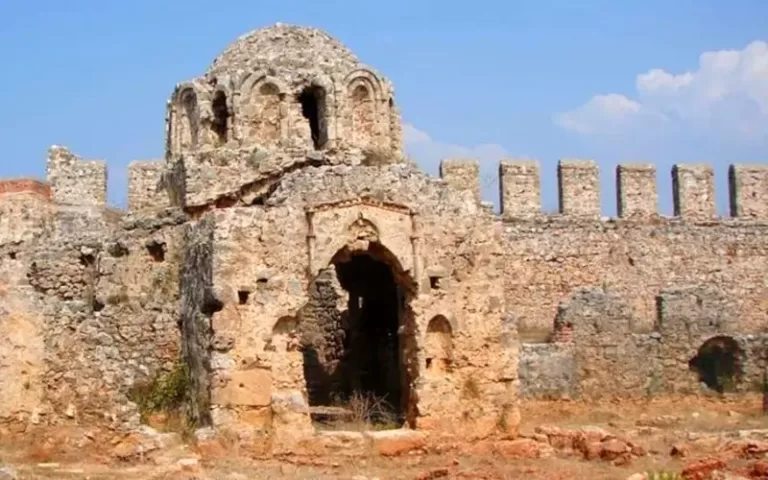Tomb of the Egyptian God Osiris – found in Necropolis

For thousands of years, the mysteries of the ancient Egyptians have captivated the imagination of people around the world. From the Great Pyramids of Giza to the enigmatic hieroglyphics, these wonders of the past remain unexplained. One of the most intriguing mysteries is the Egyptian God Osiris ‘s tomb.
This mysterious tomb is believed to contain the remains of the Egyptian God of the dead, Osiris. It has an ancient structure located in a necropolis near the city of Abydos. It is a source of much speculation and study. The mystery of the Tomb of Osiris has enticed archaeologists and historians worldwide for centuries.
Unveiling this ancient structure’s mysteries is an adventure sure to amaze. Researchers discovered intricate artwork that adorns the walls and the wealth of artifacts and treasures in it.
The Egyptian god Osiris’s tomb, is a testament to the artistry and sophistication of the ancient Egyptians. Join us as we explore this mysterious structure and uncover the secrets of the long-forgotten ancient Egyptian Gods.
History of the Tomb and the Necropolis

The story of the Tomb of Osiris begins with the legend of the God Osiris himself. Every Egyptian Gods and Goddesses had significant value and different roles in the history, according to the ancient Egyptians, Osiris was a king and Egyptian God of the death. He ruled over an earthly realm known as the “Land of the Dead.”
After his death, he was said to have become the ruler of the underworld. Here he presided over the dead as they waited to be reincarnated. Osiris is often depicted as having green skin and wearing a green gown. The location of the Tomb of Osiris is located in a necropolis near the city of Abydos. Abydos was once the capital of Egypt during the Early Dynastic Period between 3100 and 3100 BC.
The necropolis is believed to have been used by a royal dynasty that ruled during this period as a final resting place. Archaeologists discovered the necropolis where the tomb was located in the late 19th century. Thousands of artifacts have been discovered in the area since then. These artifacts include statues, sarcophagi, and other goods placed in the dead’s tombs as offerings.
Artwork found in the Tomb

Egyptian art has been revered, studied, and celebrated for thousands of years. It is one of the most significant aspects of ancient Egyptian culture. Many of the most famous artifacts, such as the Sphinx and the Great Pyramids, are examples of the skillful artistry of the Egyptians.
The artwork adorns the Tomb of Osiris walls is no exception. The scenes in the Tomb illustrate the story of the God Osiris and his journey after being murdered by his brother Set. The artwork in the Tomb is famous for being some of the oldest and best-preserved examples of ancient Egyptian art found to date.
Because of this, archaeologists have studied it in great detail. They reveal insight into the culture and history of the ancient Egyptians. The artwork in the Tomb is largely done in a style known as “Osirian.” This style uses a combination of images and hieroglyphics to tell the story of the God Osiris.
Treasures Discovered in the Egyptian God Osiris Tomb
The Tomb of Osiris is said to be filled with treasures and riches beyond imagination. Unfortunately for explorers, the tomb’s location has remained a secret for thousands of years because it is impossible to open it and view the riches for themselves. However, Researchers found many artifacts in the nearby Necropolis. These artifacts have led many to believe that the Tomb of Osiris is the resting place of Osiris. Some of the most significant treasures discovered in the area include a statue of Osiris and a green-colored sarcophagus. Many statues and other artifacts have been found in the area depicting the God Osiris. All this has aided in the speculation that the tomb is indeed the resting place of the God Osiris.
Legends and Speculation Surrounding the Tomb

While the archaeologists explored the Tomb of Osiris, it has also been the subject of legends and speculation for thousands of years. One such legend is that the ancient Egyptians built the tomb to house treasures that were supposed to pay off a massive debt to the Roman Empire. The story goes that a Roman Emperor of the fourth century AD, Emperor Augustus, requested a loan from the Egyptian people.The Egyptians agreed to provide the money, but only if the Emperor built them a new capital city, which he did in the form of a city named Alexandria.
The Egyptians then used this money to pay off a debt to the Romans. But, after the debt was paid, the Egyptians couldn’t repay their new Emperor. Terrified by the thought of Emperor Augustus bringing retribution, the Egyptians allegedly hid the capital city. They built the Tomb of Osiris to hide the riches that the Egyptian people had borrowed. However, no serious scholar has accepted this legend as true, and it is generally accepted that the tomb was built as a resting place for the god Osiris.
Modern Exploration of the Tomb

Modern exploration of the Tomb of Osiris has been ongoing since the discovery of the structure in the late 19th century. Since then, many scholars Carter and George Herbert, the 5th Earl of Carnarvon, investigated the tomb. Howard Carter, best known for discovering King Tut’s tomb, was one of the first to explore the Tomb of Osiris.
George Herbert, the 5th Earl of Carnarvon, was another prominent explorer who studied the Tomb of Osiris. He led a series of excavations in the early 1900s, which revealed a large stone slab bearing hieroglyphics and many walls decorated with images of Osiris. In the early 1900s, he used a technique known as “sapping” to excavate the tomb. This process involves digging a trench around the outside of the structure and then inserting a narrow wooden or bamboo tube into the ground. Dirt is removed from the tube and then pumped out of the hole. This allowed archaeologists to excavate the tomb. It was still intact and in place, preserving it for future generations.
Significance of the Tomb in the Study of Ancient Egypt
The Tomb of Osiris is one of ancient Egypt’s most significant archaeological discoveries.
While the story of the God Osiris is fascinating, the location and careful excavation of the Tomb has allowed modern scholars to study it in detail. The artwork, and discoveries within the Tomb, have given scholars insight into the culture and history of the ancient Egyptians.
The discovery of the Tomb of Osiris has helped scholars better understand the artistry, culture, and history of the ancient Egyptians. Additionally, the Tomb has been preserved and protected by the surrounding sand. It will continue to be studied and explored for many years to come.






